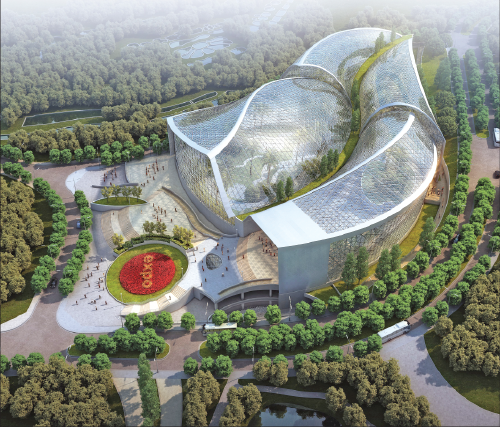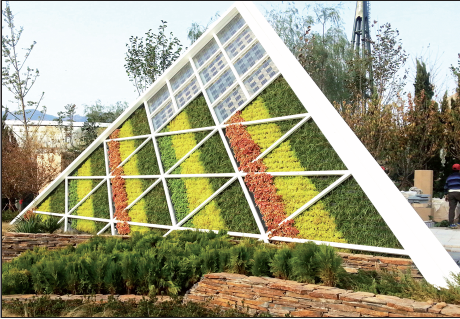
CHINA DAILY
This design sketch shows the Qingdao International Horticultural Exposition's Botanical Pavilion.

CHINA DAILY
Construction of the Hong Kong Garden at the Botanical Pavilion is almost finished.
The Olympics of horticulture, economics, science and technology will be held in Qingdao from April 25 to Oct 25. Zhang Zixuan and Xie Chuanjiao preview the event.
Qingdao, the coastal pearl of Shandong province, is back in the spotlight and ready to wow the world again as the host city of the 2014 International Horticultural Exposition, six years after successfully hosting the 2008 Olympic Sailing Regatta.
Held since 1851 and hosted more than 30 times in different cities worldwide, the International Horticultural Exposition has been crowned as the Olympics of horticulture, economy, science and technology. The non-trade global event is aimed at promoting multiple exchanges among countries and regions in various fields.
Next year will be the first time the event is staged in a coastal Chinese city. The Qingdao International Horticultural Exposition is organized by the Qingdao municipal government and sponsored by the State Forestry Administration, the China Council for the Promotion of International Trade, the China Flower Association and the Shandong provincial government. It will last for 184 days from April 25 to Oct 25 next year at Qingdao's Baiguo Mountain Forest Park in Licang district.
"The theme for QIHE is 'From the earth, for the Earth', which embodies the concepts of cultural inspiration, technological innovation and natural creation, advocating the harmony between man and nature," says QIHE Executive Committee Secretary-General Li Fengli.
Covering an area of 2.41 square kilometers, the expo draws inspiration from a Chinese fairytale about seven heavenly maids, who scattered flowers when they descended upon the human world.
The site comprises 12 themed gardens along with two reservoirs. It houses 37 exhibition areas, including major buildings, such as the Botanical Pavilion and Horticulture Center, as well as replicas of gardens from China and overseas. Some 33 of them are almost completed.
"This is the first time the expo will be gathering representatives from all provinces, autonomous regions, municipalities and special administrative regions in China," Li points out, saying that visitors can enjoy the dynamics from Weihai's seaweed houses of Shandong province to poplar trees transported from more than 8,000 km away in the Xinjiang Uygur autonomous region.
The expo has also invited participants from 37 countries and regions, most of which are sister cities with Qingdao.
"There are many interesting stories behind every country's garden design, which reflects the country's characteristics," comments Ding Yi, project manager of the QIHE Executive Committee's exhibitor invitation department.
The Perm Garden from Russia contains a pavilion in the shape of a flying saucer. The idea comes from Perm's reputation as a center of UFO sightings. Since 1962, there have been more than 200. The local government even named a Perm Anomalous Zone within the city last year.
The Georgia State Garden from the United States features five layers of walls made from different materials. The evolution from wood to rammed earth, brick, PVC piping and finally to natural green plants mirrors the development of the state. The garden is a work of a teacher-student team from the University of Georgia, and one of the student participants is from Qingdao.
At the DPRK Garden, visitors will see two kinds of begonias that are named after the country's two late leaders-the Kim Il-sung Flower and the Kim Jong-il Flower.
And Canada's Quebec Garden is designed as a pool to depict the world after all glaciers have melted.
Ding also emphasizes that many materials used by these gardens are local products. For example, the stones used by Japan's Shimonoseki Garden to form a river course are selected from Qingdao's neighboring cities, including Weihai and Linyi.
Every idea and plan has been discussed and modified several times to achieve the best presentation.
At the 24,400-square-meter Botanical Pavilion, thousands of trees and plants from different climate zones occupy the giant glass greenhouse, converting it into a forest.
"It is quite rare to see so many precious species at one time and one place," says the pavilion's landscape designer Yan Yongpei, standing beside a nearly 1,000-year-old litchi tree.
"Walking into the pavilion is like entering the world of Avatar," planning and design department employee Du Yawen says, referring to the botanically fantastical sci-fi film.
The pavilion also features a lot of oceanic plants. As part of their innovative initiatives, the executive committee launched several ocean-themed promotion projects. For example, they made drift bottles, which are then thrown into the oceans by China's scientific research ship Ocean No 1 during its journey. Those who catch a bottle can exchange it for an expo ticket.
Touching on the choice of the site-namely the Baiguo Mountain Forest Park, which sits upon a hill in the north of Qingdao-QIHE Executive Committee Secretary-General Li says it was chosen with the aim of narrowing the development gap of the two parts of Qingdao. The north of Qingdao has been lagging behind since the 1950s.
"The QIHE doesn't exist in isolation. There must be all kinds of matching systems, such as medication, emergency services and tap water. And any potential risks must be ruled out," Li stresses, saying that preparations, such as road construction and local resident relocation, have been ongoing for a long time.
He also points out the QIHE is a huge collaboration with local brands and enterprises in various fields. So far the executive committee has attracted social sponsorship worth about 300 million yuan ($492,300).
Special bus lines will run from the city center to the expo site. More than 15,000 parking spaces will be available outside the site, and visitors can use free shuttle buses around the expo garden.
The expo is estimated to receive 12 million visitors, but the number is likely to be much higher, Li says.
Major buildings, gardens and open spaces will be retained permanently after the expo.
Contact the writers through zhangzixuan@chinadaily.com.cn.
Hu Qing contributed to this story.
We recommend:
